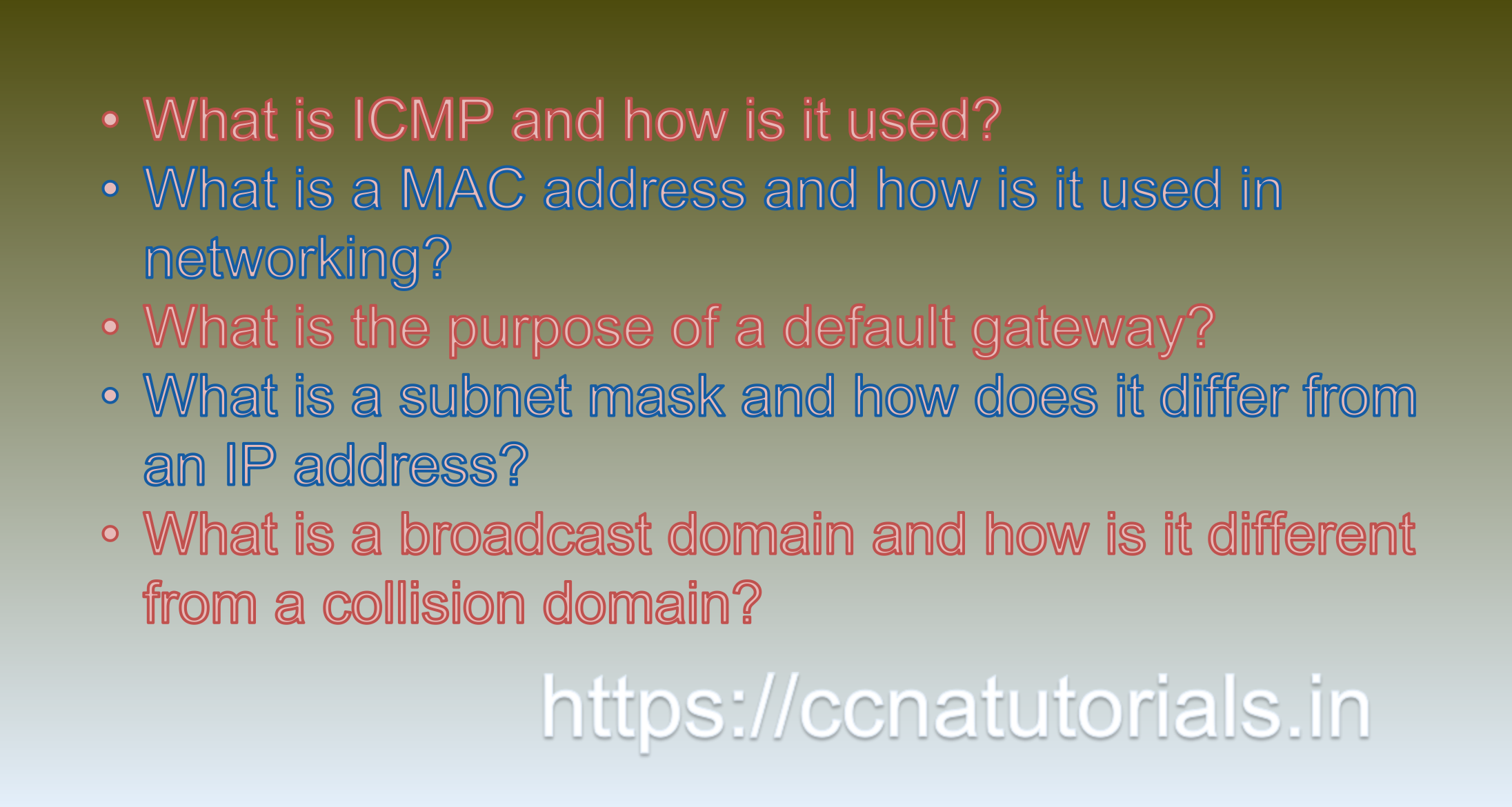Contents of this article
In this article, I describe some CCNA sample questions for practice before appearing in the CCNA 200-301 exam. The following questions are basic questions and related to the CCNA sample questions set 4. There are multiple sample questions set on this website for prior practice online. All questions are described with relevant answers. You can take the following questions and answer as reference for CCNA 200-301 exam. You may also need to do more practice with other websites and books to practice the CCNA sample questions set 4.
Question 1: What is ICMP and how is it used?
ICMP stands for Internet Control Message Protocol, which is a network protocol used for error reporting and diagnostic purposes in IP networks. It is a fundamental part of the internet protocol suite and is used by network devices to communicate error messages and operational information about network conditions.
ICMP is typically used by network devices such as routers, switches, and firewalls to report errors, diagnose network issues, and manage network traffic. For example, if a router receives a packet that it cannot deliver to its destination, it will use ICMP to send an error message back to the sender, indicating that the packet was not delivered and providing information about the reason for the failure.
In addition to error reporting, ICMP is also used for functions such as:
Ping: A utility used to test the connectivity between two devices by sending ICMP echo requests and receiving ICMP echo replies.
Traceroute: A utility used to trace the path taken by packets as they travel through a network by sending a series of ICMP packets with increasing TTL (time-to-live) values and receiving ICMP TTL exceeded messages from each intermediate router along the path.
Path MTU discovery: A mechanism used to determine the maximum transmission unit (MTU) size that can be used to transmit data between two devices without fragmentation by sending ICMP messages with varying packet sizes and detecting when an error message is received indicating that the packet size is too large for a particular link.
Overall, ICMP is a crucial protocol for managing and troubleshooting IP networks by providing diagnostic and error reporting capabilities that help network administrators to identify and resolve network issues. This is the answer to question 1of CCNA sample questions set 4.
Question 2: What is a MAC address and how is it used in networking?
A MAC address, also known as a Media Access Control address, is a unique identifier assigned to a network interface controller (NIC) for use as a network address in communications within a network segment.
In other words, a MAC address is a hardware-based identification number assigned to the network adapter of a device, such as a computer or a smartphone. The MAC address is used by the network protocol to identify the device on the network, and it is assigned by the manufacturer of the device.
MAC addresses are used in networking to enable devices to communicate with each other on the same network. When a device sends a message or packet on the network, it includes the MAC address of the intended recipient in the header of the packet. This allows the network hardware to direct the packet to the correct destination device based on its MAC address.
MAC addresses are important in networking because they enable devices to communicate with each other, and they help to ensure that data is transmitted and received accurately and efficiently. This is the answer to question 2 of CCNA sample questions set 4.
Question 3: What is the purpose of a default gateway?
A default gateway, also known as a default router, is a network device that serves as the forwarding host to other networks when no other route specification matches the destination IP address of a packet.
The purpose of a default gateway is to act as an intermediary between devices on different networks, allowing them to communicate with each other. When a device on one network needs to communicate with a device on another network, it sends the data packet to the default gateway, which then forwards the packet to the destination network.
In other words, the default gateway is the point of contact between a local network and the Internet or other networks. It serves as the exit and entry point for data between the local network and other networks, including the Internet.
A default gateway is usually assigned an IP address that is within the same subnet as the devices on the local network, and it can be a router or a layer-3 switch. The default gateway must be correctly configured on each device that needs to communicate with other networks, such as a computer, a server, or a printer, in order for those devices to communicate with devices on other networks. This is the answer to question 3 of CCNA sample questions set 4.

Question 4: What is a subnet mask and how does it differ from an IP address?
A subnet mask is a 32-bit number used in IPv4 networking to divide an IP address into two parts, the network part and the host part. The subnet mask is used to determine which part of an IP address represents the network portion and which part represents the host portion.
An IP address is a unique numerical identifier assigned to each device on a network that uses the Internet Protocol (IP) for communication. It consists of two parts: the network portion and the host portion. The network portion identifies the network to which the device belongs, while the host portion identifies the specific device on that network.
A subnet mask, on the other hand, is a binary number that is used to determine the boundaries between the network and host portions of an IP address. It is used in conjunction with the IP address to determine the network address and the host address.
The subnet mask is represented as a series of four numbers separated by dots, such as 255.255.255.0. Each number represents 8 bits of the 32-bit subnet mask. The bits that are set to 1 in the subnet mask indicate the network portion of the IP address, while the bits that are set to 0 indicate the host portion.
For example,
if an IP address is 192.168.1.100 and the subnet mask is 255.255.255.0, the first three octets of the IP address (192.168.1) are the network portion, while the last octet (100) is the host portion. The subnet mask is used to determine which part of the IP address represents the network portion and which part represents the host portion.
In summary, an IP address identifies a device on a network, while a subnet mask is used to divide the IP address into two parts, the network portion, and the host portion. This is the answer to question 4 of CCNA sample questions set 4.
Question 5: What is a broadcast domain and how is it different from a collision domain?
A broadcast domain is a logical division of a computer network, where all devices can reach each other by broadcasting messages to all other devices within the same broadcast domain. In other words, devices in the same broadcast domain can send broadcast packets that are delivered to all devices in the domain.
A broadcast domain is determined by the configuration of the network devices, such as routers, switches, or VLANs. A router, for example, creates a boundary between different broadcast domains, while a switch or a VLAN can create a single broadcast domain.
On the other hand, a collision domain is a network segment where devices share the same physical medium, such as a hub or a shared Ethernet segment. In a collision domain, when two or more devices transmit data at the same time, a collision occurs and the data is lost. Collisions can occur when devices are connected to a hub, which broadcasts all data to all devices on the same segment, causing the risk of data collision.
A collision domain is different from a broadcast domain in that a broadcast domain defines the scope of broadcast packets, while a collision domain defines the scope of data collisions. In other words, a broadcast domain is a logical division of a network based on the broadcast traffic, while a collision domain is a physical segment of a network where data collisions can occur.
In modern networks, collisions are typically avoided by using switches instead of hubs and implementing protocols like CSMA/CD (Carrier Sense Multiple Access with Collision Detection). Meanwhile, broadcast domains can be controlled through the use of VLANs, network segmentation, and routing. This is the answer to question 5 of CCNA sample questions set 4.
Conclusion for CCNA sample questions set 4
In this article, I described 5 questions with answers related to CCNA 200-301 exam. I hope you found these questions helpful for the practice of the CCNA 200-301 exam. You may drop a comment below or contact us for any queries related to the above questions and answers for CCNA 200-301. Share the above questions If you found them useful. Happy reading!!






